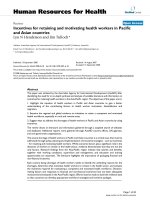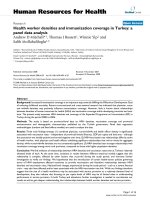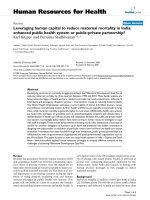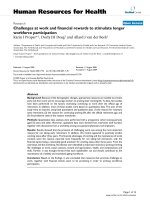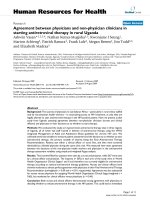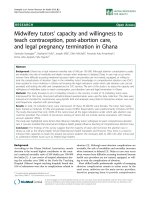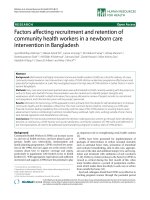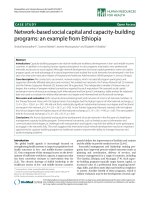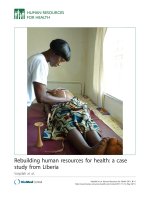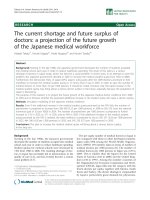báo cáo sinh học:" Network-based social capital and capacity-building programs: an example from Ethiopia" pdf
Bạn đang xem bản rút gọn của tài liệu. Xem và tải ngay bản đầy đủ của tài liệu tại đây (965.51 KB, 11 trang )
Ramanadhan et al. Human Resources for Health 2010, 8:17
/>Open Access
CASE STUDY
© 2010 Ramanadhan et al; licensee BioMed Central Ltd. This is an Open Access article distributed under the terms of the Creative Com-
mons Attribution License ( which permits unrestricted use, distribution, and reproduc-
tion in any medium, provided the original work is properly cited.
Case study
Network-based social capital and capacity-building
programs: an example from Ethiopia
Shoba Ramanadhan*
1
, Sosena Kebede
2
, Jeannie Mantopoulos
2
and Elizabeth H Bradley
2
Abstract
Introduction: Capacity-building programs are vital for healthcare workforce development in low- and middle-income
countries. In addition to increasing human capital, participation in such programs may lead to new professional
networks and access to social capital. Although network development and social capital generation were not explicit
program goals, we took advantage of a natural experiment and studied the social networks that developed in the first
year of an executive-education Master of Hospital and Healthcare Administration (MHA) program in Jimma, Ethiopia.
Case description: We conducted a sociometric network analysis, which included all program participants and
supporters (formally affiliated educators and mentors). We studied two networks: the Trainee Network (all 25 trainees)
and the Trainee-Supporter Network (25 trainees and 38 supporters). The independent variable of interest was out-
degree, the number of program-related connections reported by each respondent. We assessed social capital
exchange in terms of resource exchange, both informational and functional. Contingency table analysis for relational
data was used to evaluate the relationship between out-degree and informational and functional exchange.
Discussion and evaluation: Both networks demonstrated growth and inclusion of most or all network members. In
the Trainee Network, those with the highest level of out-degree had the highest reports of informational exchange, χ
2
(1, N = 23) = 123.61, p < 0.01. We did not find a statistically significant relationship between out-degree and functional
exchange in this network, χ
2
(1, N = 23) = 26.11, p > 0.05. In the Trainee-Supporter Network, trainees with the highest
level of out-degree had the highest reports of informational exchange, χ
2
(1, N = 23) = 74.93, p < 0.05. The same pattern
held for functional exchange, χ
2
(1, N = 23) = 81.31, p < 0.01.
Conclusions: We found substantial and productive development of social networks in the first year of a healthcare
management capacity-building program. Environmental constraints, such as limited access to information and
communication technologies, or challenges with transportation and logistics, may limit the ability of some participants
to engage in the networks fully. This work suggests that intentional social network development may be an important
opportunity for capacity-building programs as healthcare systems improve their ability to manage resources and
tackle emerging problems.
Introduction
The global health agenda is increasingly focused on
strengthening health systems to improve population-level
health outcomes in low- and middle-income countries
[1]. One component of this strategy focuses on the devel-
opment of sufficient workforce capacity, a target area that
has been somewhat resistant to intervention thus far
[2,3]. The chronic shortage of skilled leadership in the
healthcare sectors of low- and middle-income countries
greatly hinders the improvement of facilities and systems
and the ability to provide needed services [2,4-6].
Successful management and leadership training pro-
grams have improved process-related outcomes (such as
planning and coordination, delivery of services, and
resource management) in a range of countries, including
The Gambia, Ethiopia, and Nicaragua [7-9]. Such capac-
ity-building programs typically target human capital, or
increased value of a professional from acquiring knowl-
edge, skills, and other assets that may benefit an employer
or system. Another benefit of these programs, which is
seldom evaluated, may be the development of social capi-
* Correspondence:
1
Center for Community-Based Research, Dana-Farber Cancer Institute, 44
Binney St., LW 703, Boston, MA 02115 USA
Full list of author information is available at the end of the article
Ramanadhan et al. Human Resources for Health 2010, 8:17
/>Page 2 of 11
tal, or resources that exist in a social structure and can be
retrieved and utilized to meet specific goals [10].
Taking a broad view of potential benefits is consistent
with current perspectives on capacity-building, which
focus on processes that assist individuals, organizations,
and societies in efforts to manage, develop, and utilize the
resources at their disposal to solve problems [3,11], here
those related to healthcare. This view represents an
intentional shift away from programs focused on techni-
cal assistance and knowledge transfer towards an endoge-
nous process, owned and driven by those who will
ultimately benefit from and sustain changes in their sys-
tems [3]. Capacity-building program participants (and
the organizations for which they work) can benefit from
increased social capital as participants are able to utilize
relationships to increase their effectiveness and perfor-
mance [10,12,13]. In this way, participants can leverage
relationships to improve communication and collabora-
tion across and within organizations to reach a common
goal [14,15]. Such benefits are particularly important in
low-resource settings as organizations are expected to
turn to external sources to find needed resources [16].
A network perspective on social capital
Although there are a wide range of conceptualizations of
social capital [17], we take a network perspective, which
holds that the extent to which an individual can realize
the benefits of social capital is a function of that individ-
ual's position in a given social network [10,18]. This
drives our focus on: a) the resources that can be accessed
by network members (either directly or through con-
tacts), and b) the structure of relationships or linkages in
a network of interest [10]. In a professional network, key
benefits of increased social capital among colleagues
include increased exchange of information and resources
[17,19]. For example, sharing of appropriate and timely
information allows individuals to make strategic adjust-
ments to reach their goals [10,20]. Additionally, partici-
pants can access novel information by developing
relationships with individuals who are dissimilar in terms
of experience and professional contacts [21]. By learning
in the context of social relationships, network members
can come together to identify pressing problems, make
sense of complex changes in the environment, and
develop innovative solutions [22,23]. Provision of tangi-
ble support or material resources from one network
member to another also improves network members' per-
formance [24]. By tapping into relationships, network
members can gain access to contacts' resources, and per-
haps more importantly, to the resources held by the orga-
nization(s) represented by those contacts [25]. The
challenge is to balance efficiency (knowing others who
have contacts and resources that are very different than
one's own) and effectiveness (development of a strong set
of key contacts) [18].
Social network analysis provides the necessary tools for
our analysis as the methodology allows for the assess-
ment of structures in social relationships, as well as the
resources exchanged through those relationships [26].
Additionally, given that successful capacity-building
relies on changes at the individual, organizational, and
system levels [27], the ability to assess relationships and
resource flow at multiple levels allows for a holistic
assessment. For example, a network in which all members
are connected prompts members to develop trust and a
sense of obligation towards each other and encourages
the generation of social capital [28]. At the same time, at
the individual level, connections to other network mem-
bers are expected to provide new access to resources for
program participants. If a capacity-building program
results in network structures that support resource
exchange, network-based social capital can have an
impact on the ultimate goal of management training pro-
grams: the improvement of trainee performance.
Despite the number of programs focused on building
healthcare worker capacity [2,7-9] and the understanding
that increased collaboration and partnerships are impor-
tant outcomes of capacity-building efforts [29], we are
not aware of previous studies examining how such pro-
grams may affect the structure and functioning of result-
ing social networks. Examining this potential impact is
important to our understanding of the full impact of
capacity-building programs in health. Using survey data
from hospital executives participating in an executive-
education program in Ethiopia [30], we conducted a
social network analysis to examine the growth of the net-
work and the social capital generated by the network (in
the form of resource exchange) during the first year of the
program. Social network development and social capital
generation were not explicit goals of the training pro-
gram, but we were able to take advantage of this natural
experiment to test exploratory hypotheses. We expected
to find growth and resource exchange within networks as
well as a positive association between network connec-
tions and resource exchange. We tested these assump-
tions among a network of program participants and
among a network of participants plus educators and men-
tors participating in the program.
Case description
Study setting
The capacity-building program under study was a two-
year executive-education Master of Hospital and Health-
care Administration (MHA) program in Ethiopia devel-
oped by the Federal Ministry of Health (FMOH), the
Clinton HIV/AIDS Initiative (CHAI), Jimma University,
and the Yale School of Public Health [9,31]. The program
Ramanadhan et al. Human Resources for Health 2010, 8:17
/>Page 3 of 11
was implemented at the request of the FMOH, with the
goal of developing skilled executives to improve hospital
management in Ethiopia, a low-resource, high-demand
setting. This program was part of a larger quality
improvement effort targeting the Ethiopian healthcare
system, which began decentralization in 1994. The course
was offered by Jimma University in Jimma, Ethiopia and
was the first graduate-level program for hospital manage-
ment in the country. The course was administered and
taught jointly by faculty from Jimma and Yale Universi-
ties, with local coordination provided by a Program
Director and Program Assistant. As an executive-educa-
tion program, the course was offered over two years, with
three-week long sessions in residence three times per
year, as well as regular progress reports and evaluations
when trainees were working at their hospitals.
Executives of public hospitals were eligible to apply.
The course focused on improving trainees' skills in a
range of management-related areas, such as human
resources, hospital operations, financial management,
strategic planning, and leadership. Trainees also had the
opportunity to develop professional connections with
each other as well as with leaders and mentors in Ethiopia
and the United States.
Study design and respondents
We conducted a cross-sectional study at the end of the
first year of the MHA program to describe the social net-
works that developed during the year. Data were col-
lected with a self-administered survey of two groups of
respondents: trainees and supporters. Trainees were the
first Chief Executive Officers (CEOs) of public hospitals
in Ethiopia. Supporters comprised educators and men-
tors formally linked with the MHA program through
either Yale or Jimma University or through CHAI. We
contacted all 25 trainees enrolled in the MHA program
and 38 supporters affiliated with the program to com-
plete the survey. All research procedures were approved
by the Human Investigation Committee at the Yale
School of Public Health and the Institutional Review
Board at Jimma University.
Data collection and measures
The self-administered survey was distributed in Decem-
ber 2008 and January 2009 and required approximately
20 minutes to complete. Paper copies of the survey were
distributed to all trainees in residence during the Decem-
ber course session and electronic copies were distributed
to all other respondents. Surveys were administered in
English, which was the language of instruction and a
requirement for participants in the MHA program.
For this study, we focused on two networks: 1) the
Trainee Network, which was comprised solely of trainees,
and 2) the Trainee-Supporter Network, which included
trainees and supporters (educators and mentors).
Respondents were presented with a roster that listed all
trainees and supporters. The survey asked all respon-
dents to identify trainees and supporters with whom they
interacted for professional purposes. Respondents also
noted whether or not they were acquainted with each
network member before the MHA program started. From
these responses, we derived our measures of interest for
each network.
We measured a series of network characteristics which
have been shown in other settings to promote exchange
of information and flow through networks [26]. These
measures were based on data about connections (or
reported relationships) between network members. Some
measures focus on presence or absence of a connection,
whereas others include information about the 'direction'
of the connection. For the latter, the measure can capture
whether Member X reported a connection to Member Y,
Y reported a connection to X, or both reported a connec-
tion to each other.
To describe the network as a whole, the first measure of
interest was network density, or the proportion of possi-
ble relationships between members that were realized,
which described the extent to which network members
are connected, regardless of the direction of connections
[26]. A more dense, or more highly connected, network
may be useful for sharing information and resources and
cooperation, whereas a more sparsely connected network
may provide greater access to diverse contacts and novel
resources [10,18]. A density level of around 15-20% is
expected to support knowledge-sharing in a network of
about 100 members [32]. We also identified isolates, indi-
viduals who reported no connections to other network
members. Isolates are of interest as their lack of connec-
tions prevents them from contributing to or benefiting
from network membership. Last, we identified compo-
nents, or subgroups of members that are not connected
to each other and therefore cannot share information and
resources between subgroups [26].
Shifting our focus to individual network members, we
calculated degree, the number of connections between a
given network member and all other network members,
regardless of the direction of ties [33]. The bulk of our
analyses focused on out-degree, or connections from a
given network member to other network members. Thus,
if Member X reported three connections with other net-
work members, that member's out-degree value would be
three, regardless of how many network members
reported connections to Member X. Compared with
degree, this measure narrows the focus to connections
that may be perceived as functionally useful to respon-
dents [34]; here, these connections involve the set of indi-
viduals from whom respondents may seek and gain skills.
In the Trainee Network, 'trainee out-degree' was the
Ramanadhan et al. Human Resources for Health 2010, 8:17
/>Page 4 of 11
number of connections a trainee reported regarding
other trainees, grouped into tertiles. In the Trainee-Sup-
porter Network, 'trainee-supporter out-degree' was the
number of connections to supporters reported by each
trainee, grouped into tertiles. Last, geographic homophily
referred to whether or not pairs of network members
worked in the same region.
To assess potential by-products of social network
development, we measured informational and functional
exchanges, which are complementary manifestations of
social capital that can help trainees achieve work-related
goals [10,24]. Informational exchange refers to access to
necessary knowledge, the ability to transmit it to the cor-
rect person, and acquisition of information with suffi-
cient time to react [18]. Trainees were asked whether or
not they received guidance in non-classroom settings
from: a) other trainees, and b) supporters on a series of
subjects. These topics included: problem-solving, human
resources, finance management and budgeting, basic
public health, biostatistics/research methods, hospital
operations, strategic management, health policy develop-
ment and analysis, health ethics and public health law,
leadership, and management information or tools. The
list of topics was defined in the curriculum as critical to
the program and most topics, but not all, were covered in
the MHA course at the time of the survey. We created a
summary score of the total number of exchanges
reported and dichotomized responses at the 50
th
percen-
tile for each network, resulting in categories of 'low
exchange' and 'high exchange' for each network. Based on
the distribution of data, 'low exchange represents zero
reported informational exchange in the Trainee Network.
Functional exchange described the provision of tangi-
ble support from one network member to another [24].
Such exchange often involves collaboration between
institutions or individuals that benefit one party to a
greater degree, e.g., one individual training another on
the use of a new tool. Examples of tangible support can
include sharing of useful tools, policies, and materials or
serving as a reference for colleagues [25,35]. Trainees
were asked whether or not they received a series of tangi-
ble resources from: a) other trainees, and b) supporters.
These resources included: materials and goods (such as
surplus supplies), connections/introductions, and hands-
on instruction, such as through site visits. We created a
summary score of the total number of exchanges
reported and dichotomized responses at the 50
th
percen-
tile for each network, resulting in categories of 'low
exchange' and 'high exchange' for each network.
Analysis
We conducted a sociometric network analysis for both
the 25-member trainee network and for the larger 63-
member trainee-supporter network, which included edu-
cators and mentors (n = 38) in addition to trainees (n =
25). Sociometric analyses assess the connections between
all members of each network of interest, supporting eval-
uation of network growth and resource exchange [36,37].
Thus, an individual who was invited to participate, but
did not fill out a survey, could have been noted as a con-
tact by another respondent and would still appear in the
dataset. Although the Trainee Network is wholly con-
tained within the Trainee-Supporter Network, we ana-
lyzed them separately to be able to isolate resource
exchange among complementary sets of ties that are
important for trainees.
Network analysis requires dedicated software to assess
relational data, and we used UCINET-6 [38]. As network
data are not independent and do not meet the assump-
tions of classical statistical techniques, we utilized proce-
dures developed for network data available in the
UCINET software package [38,39]. Thus, the significance
tests were based on random permutations of matrices as
is appropriate for relational data. Here, the significance
levels were determined based on distributions created
from 10 000 random permutations. The analytic proce-
dures also supported comparison of matrices of data.
Descriptive measures were calculated using standard
UCINET procedures developed for network data. We uti-
lized UCINET Contingency Table Analysis to assess the
association of out-degree with two types of resource
exchange. We tested the relationship between geographic
homophily and connection patterns using UCINET QAP
Relational Cross-Tabulation.
Results
Trainee network
Among trainees, 23 of 25 individuals completed the sur-
vey (92% response rate). Table 1 describes the character-
istics of trainees' hospitals. The trainee hospitals had on
average 204 beds with a range of 40-800 beds, and the
average number of employees per hospital was 399
employees, with a range of 82-2500 employees. The
majority of hospitals (72%) were classified as regional;
one-third were rural.
The network graphs comparing connections before the
program started at year 1 (Figure 1) and key network
measures (Table 2) demonstrate network-level growth.
The network transitioned from having seven isolates
(individuals who were not connected to anyone) and two
components (distinct and isolated subgroups) to having
zero isolates and only one component. At year 1, the net-
work demonstrated closure, or the ability of all members
to connect with each other, either directly or through
contacts. The density of connections increased from 4%
to 13% of all potential connections over the year. In terms
of resource exchange, 55% of trainees reported that they
had informational exchanges with other trainees during
Ramanadhan et al. Human Resources for Health 2010, 8:17
/>Page 5 of 11
the first year of the program. The same percentage
reported functional exchange with other trainees. We
found that trainee out-degree (the number of connec-
tions reported by the trainee regarding other trainees)
increased from 1.0 to 3.0 connections in the first year of
the program, which was not a statistically significant
increase. We found increased variation in trainee out-
degree and trainee in-degree values at year 1 compared
with the beginning of the program, suggesting that the
network became more centralized, or more centred on a
subset of individuals.
At year 1, trainees in the lowest out-degree tertile aver-
aged 0.5 outgoing connections compared with an average
of 2.0 outgoing connections for the middle tertile, and 6.1
outgoing connections for the highest tertile. Individuals
with the highest level of connections were more likely to
be working in the capital city of Addis Ababa compared
with other regions (Fisher's exact test, p = 0.03). We
found a significant (p < 0.001) association between
regional homophily and connections reported at year 1.
Of potential connections among individuals from the
same region, 45% (45 of 100) were reported compared
with 6% (30 of 500) of potential connections among indi-
viduals from different regions.
As presented in Table 3, we found that at year 1, trainee
out-degree was positively associated with informational
exchange, χ
2
(1, N = 23) = 123.61, p < 0.01. Those with the
highest tertile of trainee out-degree had the highest
reports of informational exchange. We did not find a sta-
tistically significant relationship between trainee out-
degree and functional exchange, χ
2
(1, N = 23) = 26.11, p >
0.05.
Trainee-Supporter Network
For the larger network, 41 of 63 individuals completed
the survey (65% response rate), with a 47% response rate
among supporters. Network-level growth was assessed
using a pair of network graphs (Figure 2) and a series of
complementary measures (Table 4). The density
Table 1: Descriptive characteristics for hospitals led by
trainees (n = 25).
nRange
Hospital location
Rural 8 (32%)
Urban 17 (68%)
Number of beds: mean 204 40-800
Number of employees: mean 399 82-2500
Hospital classification
Federal 4 (16%)
Regional 18 (72%)
Sub-regional/Zonal 3 (12%)
Figure 1 MHA trainee network before the program started (left) and at year 1 (right), n = 25. Key: Circular nodes represent trainees. Node size
represents degree (number of connections); nodes in upper left corner of diagram on left represent isolates (individuals who did not report any con-
nections).
Ramanadhan et al. Human Resources for Health 2010, 8:17
/>Page 6 of 11
increased from 3% to 13% of all potential ties realized
over the first year of the program. We analyzed density
increases among subgroups and found increased ties
from trainees to supporters (3% to 20%), from supporters
to trainees (0% to 12%) and from supporters to support-
ers (5% to 9%). The number of isolates decreased from 8
to 2 in this network, and there was only one component
at year 1, ignoring isolates. Again, increased variation in
out-degree and in-degree values for the full network from
the beginning of the program to year 1 suggests that the
network became more centralized. Assessing the overall
network, the individuals with the most connections in
this network were mainly faculty and staff that played a
central role in program administration and teaching.
Table 2: Descriptive measures for the trainee-only sociometric network (25-member network)
Measure Pre-MHA Year 1
Network-level measures
Density (proportion of potential ties that were actually realized) 0.04 0.13
Isolates (members of the network not connected to anyone else) 7 0
Components (distinct and isolated subgroups in the network) 2 0
Individual-level measures
Degree (all connections reported to/from the respondent) Mean: 1.92 Mean: 4.88
SD: 1.79 SD: 4.42
Trainee out-degree (number of connections reported by respondent
regarding others)
Mean: 1.04 Mean:3.00
SD: 1.43 SD: 4.62
Trainee in-degree (number of connections reported regarding
respondent by others)
Mean: 1.04 Mean: 3.00
SD: 1.25 SD: 1.67
Table 3: Relationship between trainee out-degree and resource exchange at year 1, contingency table analysis (n = 23).
Informational: no
exchange (%)
Informational: some
exchange (%)
Functional: no
exchange (%)
Functional: some
exchange (%)
Trainee out-degree
Low 70.00 8.33 40.00 33.33
Medium 10.00 33.33 30.00 16.67
High 20.00 58.33 30.00 50.00
Observed X
2
123.61** 26.11
Key: ~ < 0.10, * p < 0.05, ** p < 0.01, *** p < 0.001
Ramanadhan et al. Human Resources for Health 2010, 8:17
/>Page 7 of 11
When we narrowed our focus to relationships between
trainees and supporters, we found that at year 1, 94% of
trainees reported informational exchange with support-
ers and 55% reported functional exchange with support-
ers. The average trainee-supporter out-degree at year 1
was 8.1 connections. In this network, the average number
of outgoing connections with supporters was 2.3 for the
lowest trainee-supporter out-degree tertile, 5.3 for the
middle tertile, and 14.9 for the highest tertile. Trainee-
supporter out-degree did not vary significantly between
regions.
As seen in Table 5, trainee-supporter out-degree was
positively associated with informational exchange, χ
2
(1, N
= 23) = 74.93, p < 0.05. Those in the highest tertile of
trainee-supporter out-degree also had the highest reports
of informational exchange. We found a similar pattern for
trainee-supporter out-degree and functional exchange,
χ
2
(1, N = 23) = 81.31, p < 0.01.
Discussion and evaluation
We found substantial development of social networks
within the context of a capacity-building program in
healthcare management. Through involvement with the
MHA program, participants developed professional con-
nections with each other and with supporters, including
faculty in Ethiopia and hospital executives in the United
States of America. These connections supported valuable
exchanges including information relating to hospital
management and resources such as hands-on assistance.
The networks that developed through the first year of
this program demonstrated several characteristics that
have been shown to support resource exchange such as
sufficient network density and connections between all or
almost all members [26,32]. We found that the number of
connections within the network was associated with like-
lihood of resource exchange, as hypothesized based on
extant social network literature [10,40]. This level of
growth and exchange may be expected in high-resource
professional settings, such as corporations, academic
institutions, or hospital systems in high-income countries
[32,41] but is impressive in a low-resource setting given
the level of investment required to support network
development [40]. The growth is also notable given that
network development was not an explicit goal of the
training program.
Although the network growth and resource exchange
are promising, limited resources for communication may
have inhibited network development of some network
members. We found that the network of program partici-
pants centered on a subset of individuals from the capitol
city of Addis Ababa. The centralization of the network is
important because the literature suggests that central
members of a network have higher potential to access and
utilize resources than their colleagues [10,42]. The pat-
tern may reflect the relative ease with which individuals
from Addis Ababa can interact, without communication
impediments such as transportation and logistics that
individuals from other regions may face. Information and
communication technologies, such as mobile phones or
internet, can mitigate challenges of physical distance and
logistics in low-resource settings [25]. At the time of the
study, reliable access to such technologies was limited for
individuals working outside the Addis Ababa region [43],
though these technologies may play an important role in
network development in the future. Here, reduced oppor-
tunities to communicate and interact may have had a
large impact on resource exchange in this network, as
strong connections are required to support exchange of
complex information [40].
Figure 2 Trainee-supporter network before the program started (left) and at year 1 (right), n = 63. Key: Square nodes represent supporters,
circular nodes represent trainees. Nodes in upper left corner of diagrams represent isolates (individuals who did not report any connections).
Ramanadhan et al. Human Resources for Health 2010, 8:17
/>Page 8 of 11
We also saw evidence of the benefits of diverse connec-
tions for program participants and found that program
participants were able to gain different categories of
resources from different types of network members. This
is likely a function of differential access to resources by
individuals in different organizations and levels of power
[10]. In a low-resource setting, other constraints may also
be an important driver of resource exchange. For exam-
ple, the material costs and logistical barriers associated
with providing tangible support to colleagues may be too
great for program participants. For mentors and educa-
tors, the costs of sharing both types of resources may be
lower. The severe system-level constraints experienced by
trainees were evident in a recent assessment of public
hospitals engaged in a quality improvement initiative,
including those represented by trainees in this program
[44].
Experience with the MHA program suggests that pro-
grams to build human resource capacity in low-income
countries can also increase network-based resources.
However, given the common challenges of geography and
limited communication technologies in such settings,
social network development and resource exchange will
likely be more effective if they are integrated as explicit
Table 4: Descriptive measures for the trainee-supporter sociometric network (63-member network).
Measure Pre-MHA Year 1
Network-level measures
Density (proportion of potential ties that were actually
realized)
0.03 0.13
Density between and within groups of trainees and
supporters
Ties among trainees: 0.04 Ties among trainees: 0.13
Ties from trainees to supporters: 0.03 Ties from trainees to supporters: 0.20
Ties from supporters to trainees: 0.00 Ties from supporters to trainees: 0.12
Ties among supporters: 0.05 Ties among supporters: 0.09
Isolates (members of the network not connected to
anyone else)
8 isolates 2 isolates
Components (distinct and isolated subgroups in the
network)
1 component + isolates 1 component + isolates
Individual-level measures
Degree (all connections reported to/from the
respondent)
Mean: 3.52 Mean: 14.22
SD: 3.11 SD: 10.87
Out-degree (number of connections reported by
respondent re: others)
Mean: 1.87 Mean: 8.14
SD: 2.88 SD: 10.81
In-degree (number of connections reported re:
respondent by others)
Mean: 1.87 Mean: 8.14
SD: 1.77 SD: 5.68
Trainee-supporter out-degree (number of
connections reported by trainees regarding
supporters)
Mean: 1.04 Mean: 8.26
SD: 1.46 SD: 5.82
Ramanadhan et al. Human Resources for Health 2010, 8:17
/>Page 9 of 11
goals of training programs to develop human resources
for health. For instance, curricula can be developed to
facilitate opportunities for developing new contacts. The
focus on development of relationships should extend
both to fellow trainees as well as supporters of the train-
ees, given the breadth of resources that can be accessed
through diverse contacts. Another important lesson from
the MHA experience is the importance of an enabling
environment. This program was developed at the request
of the Ethiopian government and was part of a broader
effort to reform the healthcare system, such as adopting
new hospital standards. This climate of organizational
and system change was supportive of changing
approaches to hospital management, and thus presented
an environment in which social capital exchange was
warranted and could have impact. Network development
and social capital exchange may be particularly critical in
low-resource settings as such networks can foster infor-
mation and function exchanges in inexpensive ways.
There are several limitations that help place the results
in context. First, although we had a high response rate,
some trainees and supporters did not complete the sur-
vey potentially influencing our findings. However, we
used out-degree as our independent variable, which is
robust to missing data [45]. Second, the data are cross-
sectional; thus causation cannot be assessed. However, a
connection must exist between individuals before
resources can be exchanged across that connection, so
the directionality assumed seems plausible. Third, social
desirability bias may have resulted in respondents over-
reporting connections and/or resource exchanges,
although we encouraged frank responses during survey
administration. Despite these limitations, the study is a
novel attempt to study network-based social capital in
capacity-building programs targeting healthcare work-
force development. Additionally, our assessment of
resource exchange uses a broad view of social capital in
public health settings, rather than the typical focus on
communication patterns [46].
Developing human resources for health is an interna-
tional priority in global health [47], and our paper high-
lights the importance of taking a broad view of outcomes
of capacity-building programs. Capacity-building pro-
grams provide a unique opportunity to direct interactions
between participants and potentially useful contacts
through coursework, mentoring relationships, and other
course-related activities. Active promotion of relation-
ship-building by organizations and/or program develop-
ers can support diversity of contacts and development of
strong channels for knowledge transfer [48-50]. In this
way, the workforce and system will be better equipped to
solve problems in healthcare by more effectively manag-
ing, accessing, and utilizing resources, thus truly building
capacity [10,11].
Conclusions
This analysis suggests that network-based social capital
may be a useful addition to the goals and evaluation of
capacity-building programs. As discussed by Hawe and
colleagues [11], social capital deserves further attention
in capacity-building efforts as it leaves the system under
intervention with greater ability to tackle current issues
as well as those outside the scope of the program and
future issues. Through active development of diverse pro-
fessional networks and investment in relationship-build-
ing within the context of system resource constraints,
Table 5: Reports of resource exchange by trainee-supporter connection level at year 1, contingency table analysis (n = 23)
Informational: low
exchange (%)
Informational: high
exchange (%)
Functional: no
exchange (%)
Functional: some
exchange (%)
Trainee-supporter out-degree
Low 20.00 6.67 19.51 9.76
Medium 13.33 13.33 14.63 14.63
High 20.00 26.67 19.51 21.95
Observed X
2
74.93* 81.31**
Key: ~ < 0.10, * p < 0.05, ** p < 0.01, *** p < 0.001
Ramanadhan et al. Human Resources for Health 2010, 8:17
/>Page 10 of 11
capacity-building programs can build stronger healthcare
workforces in low- and middle-income countries.
Competing interests
The authors declare that they have no competing interests.
Authors' contributions
All authors were involved in study and survey instrument design. SR con-
ducted the data analysis and drafted the manuscript. EHB, SK, and JM provided
intellectual content and manuscript revisions. All authors read and approved
the final manuscript.
Acknowledgements
The authors acknowledge the invaluable assistance of Ms. Mahlet Gebeyehu of
the Jimma-Yale MHA program. SR was funded in part by a grant from the Whit-
ney and Betty MacMillan Center for International and Area Studies at Yale. The
work for this research was also supported by the Clinton HIV/AIDS Initiative.
EHB was supported by the Patrick and Catherine Weldon Donaghue Medical
Research Foundation Investigator Award.
Author Details
1
Center for Community-Based Research, Dana-Farber Cancer Institute, 44
Binney St., LW 703, Boston, MA 02115 USA and
2
Division of Health Policy and
Administration, Yale School of Public Health, 60 College St. P.O. Box 208034,
New Haven, CT 06520 USA
References
1. Reich MR, Takemi K: G8 and strengthening of health systems: follow-up
to the Toyako summit. Lancet 2009, 373(9662):508-515.
2. World Health Organization: Everybody's business: strengthening health
systems to improve health outcomes: WHO's framework for action.
World Health Organization.: Geneva; 2007.
3. Organization for Economic Co-operation and Development: The
Challenge of Capacity Development: Working Towards Good Practice.
Development Assistance Committee, Organization for Economic Co-
operation and Development,: Paris; 2006.
4. Filerman GL: Closing the management competence gap. Human
Resources for Health 2003, 1(7):.
5. Egger D, et al.: Strengthening Management in Low-Income Countries.
Evidence and Information for Policy: World Health Organization: Geneva,
Switzerland; 2005.
6. Koplan JP, et al.: Towards a common definition of global health. Lancet
2009, 373(9679):1993-1995.
7. Conn CP, Jenkins P, Touray SO: Strengthening health management:
experience of district teams in The Gambia. Health Policy and Planning
1996, 11(1):64-71.
8. McEwan E, et al.: Developing public health management training
capacity in Nicaragua. American Journal of Public Health 2001,
91(10):1586-8.
9. Bradley E, et al.: Hospital quality improvement in Ethiopia: a
partnership-mentoring model. International Journal of Quality in Health
Care 2008, 20(6):392-399.
10. Lin N: Social capital: a theory of social structure and action. New York:
Cambridge University Press; 2001.
11. Hawe P, et al.: Multiplying health gains: the critical role of capacity-
building within health promotion programs. Health Policy 1997,
39(1):29-42.
12. Bourdieu P: The forms of capital. In Handbook of Theory and Research for
the Sociology of Education Edited by: Richardson JG. Greenwood: New
York; 1985:241-258.
13. Scott C, Hofmeyer A: Networks and social capital: a relational approach
to primary healthcare reform. Health Research Policy and Systems 2007,
5(9):.
14. March JG, Simon HA: Organizations. New York: John Wiley & Sons; 1958.
15. Perrow C: The short and glorious history of organizational theory.
Organizational Dynamics 1973, 2(1):3-15.
16. Pfeffer J, Salancik GR: The External Control of Organizations. New York:
Harper and Rowe; 1978.
17. Portes A: Social capital: its origins and applications in modern
sociology. Annual Review of Sociology 1998, 24(1):1-24.
18. Burt RS: Structural Holes: The Social Structure of Competition.
Cambridge, MA: Harvard University Press; 1992.
19. Greenhalgh T, et al.: Diffusion of innovations in service organizations:
systematic review and recommendations. Milbank Quarterly 2004,
82(4):581-629.
20. Hawe P, Webster C, Shiell A: A glossary of terms for navigating the field
of social network analysis. J Epidemiol Community Health 2004,
58(12):971-975.
21. Granovetter M: The strength of weak ties. American Journal of Sociology
1973, 78:1360-1380.
22. Lave J, Wenger E: Situated Learning: Legitimate Peripheral
Participation. Cambridge UK: Cambridge University Press; 1991.
23. Weick KE: The Collapse of Sensemaking in Organizations: The Mann
Gulch Disaster. Administrative Science Quarterly 1993, 38(4):628-652.
24. Israel BA: Social Networks and Social Support: Implications for Natural
Helper and Community Level Interventions. Health Education and
Behavior 1985, 12(65):65-80.
25. McPherson JM, Smith-Lovin L, Cook JM: Birds of a Feather: Homophily in
Social Networks. Annual Review of Sociology 2001, 27:415-444.
26. Wasserman S, Faust K: Social Network Analysis: Methods and Analysis.
New York: Cambridge University Press; 1994.
27. LaFond AK, Brown L, Macintyre K: Mapping capacity in the health sector:
a conceptual framework. International Journal of Health Planning and
Management 2002, 17:3-22.
28. Burt RS: Brokerage and Closure: An Introduction to Social Capital. New
York: Oxford University Press; 2005.
29. Crisp BR, Swerissen H, Duckett SJ: Four approaches to capacity building
in health: consequences for measurement and accountability. Health
Promotion International 2000, 15(2):99-107.
30. Kebede S, et al.: Educating Leaders in Hospital Management: A New
Model in Sub-Saharan Africa. International Journal for Quality in Health
Care 2010, 22(1):39-43.
31. Kebede S, et al.: Educating Leaders in Hospital Management: A New
Model in Sub-Saharan Africa. International Journal for Quality in Health
Care 2009 in press.
32. Parise S: Knowledge Management and Human Resource Development:
An Application in Social Network Analysis Methods. Advances in
Developing Human Resources 2007, 9(3):359-383.
33. Huang K, Provan KG: Resource Tangibility and Patterns of Interaction in
a Publicly Funded Health and Human Services Network. Journal of
Public Administration Research and Theory 2007, 17(3):435-454.
34. Hansen MT: The search-transfer problem: The role of weak ties in
sharing knowledge across organization subunits. Administrative Science
Quarterly 1999, 44(1):82-111.
35. Ozcan P, Eisenhardt KM:
Origin of Alliance Portfolios: Entrepreneurs
Network Strategies and Firm Performance. Academy of Management
Journal 2009, 52(2):246-279.
36. Valente TW: Network Models and Methods for Studying the Diffusion
of Innovations in Models and Methods in Social Network Analysis.
Edited by: Carrington PJ, Scott J, Wasserman S. Cambridge University
Press: Cambridge England; 2005:98-116.
37. Kawachi I, Subramanian SV, Kim D: Social Capital and Health: A Decade
of Progress and Beyond in Social Capital and Health. Edited by:
Kawachi I, Subramanian SV, Kim D. Springer: New York; 2008:1-26.
38. Borgatti SP, Everett MG, Freeman LC: UCINET for windows: Software for
social network analysis. Analytic Technologies: Harvard MA; 2002.
39. Krackhardt D: Predicting with social networks: Nonparametric multiple
regression analysis of dyadic data. Social Networks 1988, 10(4):359-382.
40. Reagans R, McEvily B: Network Structure and Knowledge Transfer: The
Effects of Cohesion and Range. Administrative Science Quarterly 2003,
48(2):240-267.
41. Sparrowe RT, et al.: Social networks and the performance of individuals
and groups. Academy of Management Journal 2001, 44(2):316-325.
42. Valente TW, Chou CP, Pentz MA: Community coalitions as a system:
effects of network change on adoption of evidence-based substance
abuse prevention. American Journal of Public Health 2007, 97(5):880-886.
43. Demeke M, Biru T: ICT Penetration and Usage in Ethiopia: Baseline
Study. In Department of Economics Addis Ababa University: Addis Ababa;
2002.
Received: 8 February 2010 Accepted: 1 July 2010
Published: 1 July 2010
This article is available from: 2010 Rama nadhan et al; lice nsee BioMed Centr al Ltd. This is an Open Access article distributed under the terms of the Creative Commons Attribution License ( ), which permits unrestricted use, distribution, and reproduction in any medium, provided the original work is properly cited.Human Reso urces for Health 2010, 8:17
Ramanadhan et al. Human Resources for Health 2010, 8:17
/>Page 11 of 11
44. Hartwig K, et al.: Hospital management in the context of health sector
reform: a planning model in Ethiopia. International Journal of Health
Planning and Management 2008, 23(3):203-218.
45. Costenbader E, Valente TW: The stability of centrality measures under
conditions of imperfect data. Social Networks 2003, 25:283-307.
46. Lakon CM, Godette GC, Hipp JR: Network-Based Approaches for
Measuring Social Capital in Social Capital and Health. 2008:63-81.
47. World Health Organization: Report on the WHO/PEPFAR consultation on
maximizing positive synergies between health systems and Global
Health Initiatives through work on building and sustaining health
workforce development. World Health Organization,: Washington DC;
2009.
48. Garvin DA, Edmondson AC, Gino F: Is Yours a Learning Organization?
Harvard Business Review 2008, 86(3):109-116.
49. Massoud MR, et al.: A Framework for Spread: From Local Improvements
to System-Wide Change. IHI Innovation Series white paper. Institute for
Healthcare Improvement: Cambridge MA; 2006:1-20.
50. Li LC, et al.: Use of communities of practice in business and health care
sectors: A systematic review. Implementation Science 2009, 4(27):.
doi: 10.1186/1478-4491-8-17
Cite this article as: Ramanadhan et al., Network-based social capital and
capacity-building programs: an example from Ethiopia Human Resources for
Health 2010, 8:17
